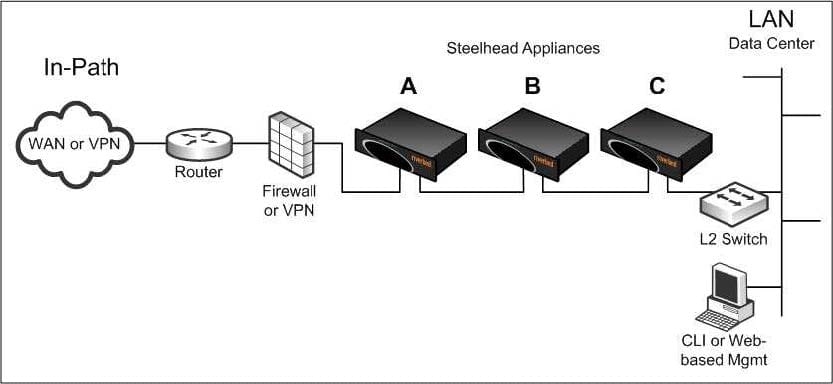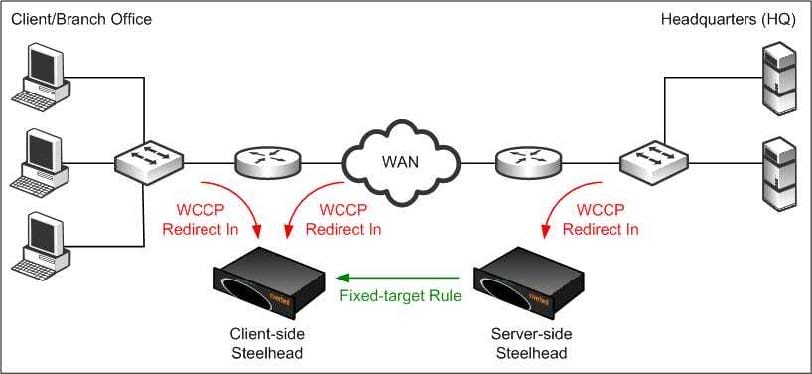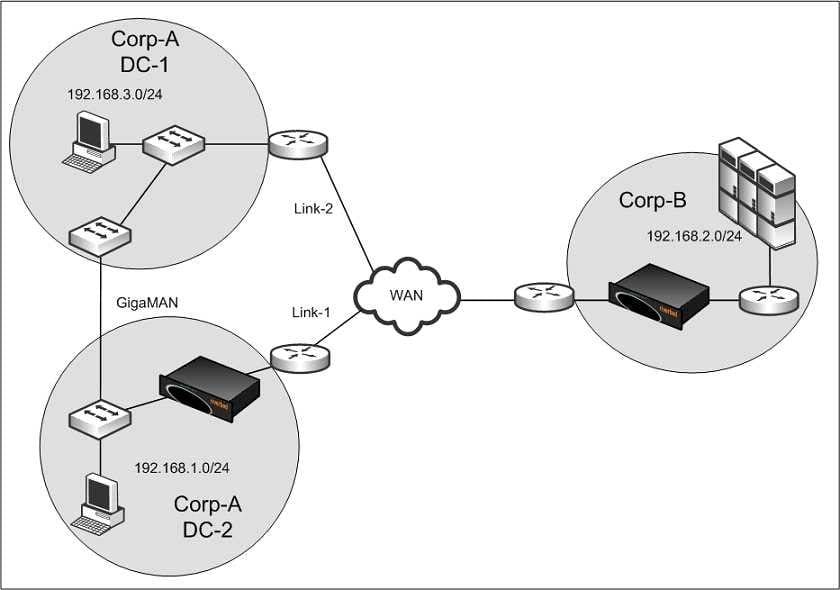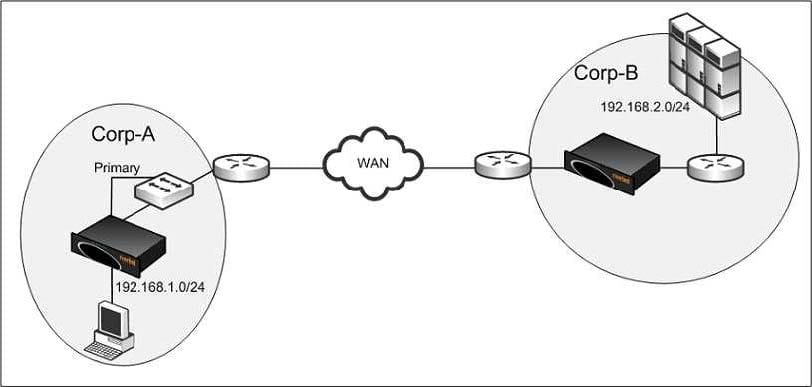Exam Details
Exam Code
:830-01Exam Name
:RCPE Certified Professional WAN OptimizationCertification
:Riverbed CertificationsVendor
:RiverbedTotal Questions
:402 Q&AsLast Updated
:Aug 06, 2025
Riverbed Riverbed Certifications 830-01 Questions & Answers
-
Question 231:
The exhibit shows a data center side serial clustering deployment. In this organization, not every remote site has a Steelhead appliance deployed, and all remote locations will be connecting to the data center.

For connections initiated from the data center, there is a possibility that the Steelhead appliances shown in the exhibit will end up peering with each other, rather than the intended remote Steelhead appliances. Where are peering rules needed to prevent this problem?
A. A only
B. B only
C. B and C
D. A and B
-
Question 232:
Refer to the exhibit.

A user from one of your branch offices reports connections to servers are failing after a new deployment. The exhibit shows how the Steelhead appliances have been deployed. Which of the following will most likely fix the issue? (Select 2)
A. Fixed-target rule is needed on the client-side Steelhead appliance
B. Change the WCCP to use Redirect Out instead of Redirect In
C. Remove Redirect-IN from the LAN at the Branch Office
D. Add Redirect-IN on the WAN at the HQ
E. Remove fixed-target rule from the server-side Steelhead appliance
-
Question 233:
The alerting threshold for CPU utilization is 70% and the reset threshold is 50%. Which of the following situations will result in an alarm being triggered? (Select 2)
A. Initial utilization of 30% becomes 75%
B. Drop from 90% of utilization to 70%
C. Initial utilization of 73% becomes 90%
D. Drop from 75% of utilization to 48% and shot up to 68%
E. Drop from 75% of utilization to 48% and shot up to 78%
-
Question 234:
Which of the following is NOT supported in Alarm Settings?
A. Raise alarm when network interface duplex errors are detected
B. Raise alarm when network interface link errors are detected
C. Raise alarm when the number of optimized connections exceeds user specified limit
D. Raise alarm if a software version mismatch is detected in the network
E. Raise alarm when asymmetric routes are detected
-
Question 235:
Refer to the exhibit.

Traffic going from Corp-A-DC-2 towards Corp-B will always use Link-1. Traffic from Corp-B back to CorpA-DC-1 may traverse Corp-A-DC-1, over the GigaMAN before it reaches Corp-A-DC-2. No TCP connections are initiated from Corp-B to either Corp-A-DC-1 or Corp-A-DC-2. Unfortunately, the customer does not have any money to purchase any additional Steelheads. What are some possible fixes to ensure optimization occurs while Link-1 is operational? (If Link-1 ceases to function, optimization is not possible.) (Select 2)
A. Configure a fixed-target rule on the Corp-A-DC-2 Steelhead pointing to the Corp-B Steelhead on port 7800
B. On the Corp-B Steelhead, enable "in-path probe direct"
C. On the Corp-A-DC-2 Steelhead, enable "in-path probe direct"
D. Configure the Corp-A-DC-2 Steelhead to inject a route into the network
E. Enable Full Transparency
-
Question 236:
You have an in-house HTTP application running on port 8443 but you are not seeing HTTP optimization. You checked and made sure that the HTTP blade is enabled. What is the likely problem?
A. Primary port needs to be on the LAN side of the Steelhead
B. There is a separate license key for the HTTP blade
C. The HTTP blade will only work on port 80 and 8080 and can not be changed
D. The HTTP blade only supports HTTP 1.1 and the application is using HTTP 1.0
E. HTTP blade is enabled by default on port 80 and 8080. An in-path rule is necessary for all other ports.
-
Question 237:
Refer to the exhibit.

You configured CIFS prepopulation at Corp-A but it is not working. What is likely the cause of the issue?
A. CIFS prepopulation requires WCCP
B. Primary interface needs to be on a different subnet C. CIFS prepopulation requires a fixed-target rule
D. The Primary interface needs to be on the LAN side of the Steelhead appliance
E. CIFS prepopulation requires SMBv2
-
Question 238:
Refer to the HTTP trace exhibit.

You noticed in the HTTP reports that you are not seeing any hits. What is required in order for HTTP optimization to work?
A. Client request is missing the "Cache" header
B. Keep-alive timeout on the server it too short
C. Server does not support HTTP 1.1 extensions
D. The "Content-Length" is too long. The HTTP blade can only handle 16K of data.
E. Server is not setting a cookie
-
Question 239:
Refer to the exhibit.

You noticed the following entry in the logs. What is the cause of the problem?
A. Complete asymmetry
B. Server-side asymmetry
C. Client-side asymmetry
D. Multi-syn retransmit
E. SYN retransmit
-
Question 240:
A Windows Vista client tries to download a file from a Windows 2008 server over a 45Mbps link with 200ms. Assuming the connection is optimized, given the default configuration on the Steelhead, what optimization techniques would be applied? 1) Data Streamlining 2) Transport Streamlining 3) MS-SQL Transaction Prediction 4) HighSpeed TCP 5) MX-TCP
A. 1, 2, 3
B. 1, 2
C. 1, 2, 3, 4
D. 1, 2, 3, 5
E. 1, 3, 4
Related Exams:
101-01
Riverbed Certified Solutions Associate201-01
Riverbed Certified Solutions Associate - Network Performance Management299-01
Riverbed Certified Solutions Professional - Network Performance Management499-01
Riverbed Certified Solutions Professional - Application Performance Management501-01
Riverbed Certified Solutions Associate - Hyper-converged Branch599-01
Riverbed Certified Solutions Professional - Storage Delivery Exam810-01
RCPE Certified Professional Network & Infrastructure Visibility830-01
RCPE Certified Professional WAN Optimization
Tips on How to Prepare for the Exams
Nowadays, the certification exams become more and more important and required by more and more enterprises when applying for a job. But how to prepare for the exam effectively? How to prepare for the exam in a short time with less efforts? How to get a ideal result and how to find the most reliable resources? Here on Vcedump.com, you will find all the answers. Vcedump.com provide not only Riverbed exam questions, answers and explanations but also complete assistance on your exam preparation and certification application. If you are confused on your 830-01 exam preparations and Riverbed certification application, do not hesitate to visit our Vcedump.com to find your solutions here.